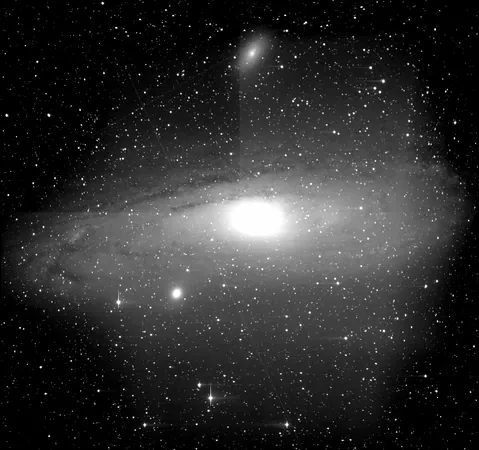
Glimpse into Andromeda: A Spectacular Celestial Snapshot of One Trillion Stars
2025-06-08
Author: Wei
Unveiling Andromeda: The Nearest Giant Galaxy
The European Space Agency (ESA) presents a breathtaking image of Andromeda, our Milky Way's closest spiral galaxy, marking today’s stunning Image of the Day.
Capturing Galaxies in a Single Shot
Captured by ESA's Flyeye telescope during its inaugural light campaign in May 2025, this extraordinary image showcases Andromeda in a single frame—a feat previously unimaginable. This powerful demonstration came from 16 simultaneous 30-second exposures, each meticulously covering a segment of the galaxy.
Unlike the NASA/ESA Hubble Space Telescope, which took over 10 years and 600 snapshots to portray Andromeda, Flyeye managed to encapsulate the entire galaxy with astonishing efficiency. In fact, this incredible shot is merely one-sixteenth of Flyeye’s expansive field of view.
Innovation Meets Astronomy: The Flyeye's Legacy
Inspired by the multi-faceted eyes of insects, the Flyeye telescope is revolutionizing how we examine the night sky. While its primary mission focuses on planetary defense—scouting for near-Earth objects—it’s also proving invaluable for wide-field astrophotography.
Once fully operational, the network of Flyeye telescopes will monitor up to two-thirds of the visible sky three times nightly, enhancing our capacity to spot moving objects and transient phenomena in real-time.
Delving Deeper into Andromeda's Secrets
Andromeda, located a staggering 2.5 million light-years away, spans over 220,000 light-years—more than double the size of the Milky Way. It’s estimated to house one trillion stars, far exceeding the stellar count of our galaxy.
The Andromeda Galaxy is slowly approaching the Milky Way, with astronomers predicting a magnificent merger in about 4 billion years that will ultimately create a colossal elliptical galaxy. Luckily, individual stars within each galaxy aren’t expected to collide due to vast distances, making this cosmic dance a fascinating sight rather than a catastrophic event.
The Allure of Andromeda
To the naked eye, Andromeda appears as a faint stretch in dark skies, particularly visible during autumn months in the Northern Hemisphere. Binoculars or a small telescope reveal its vibrant core and spiral arms, accompanied by its satellite galaxies, M32 and M110.
A pivotal member of the Local Group—a cluster of around 80 galaxies—Andromeda enriches our understanding of galactic formation and evolution. With its extensive studies spanning various wavelengths, scientists continue to uncover its myriad secrets, including a massive halo of hot gas surrounding the galaxy.
The Future of Andromeda and Our Galaxy
Andromeda stands as a monumental object of study, offering valuable insights into the fate of our Milky Way. Observing its beauty inspires both scientists and skywatchers alike and provides a glimpse into what awaits when our two galaxies eventually collide in the distant future.
Breathtaking images like these not only captivate but also fuel our desire to explore the cosmos further.


 Brasil (PT)
Brasil (PT)
 Canada (EN)
Canada (EN)
 Chile (ES)
Chile (ES)
 Česko (CS)
Česko (CS)
 대한민국 (KO)
대한민국 (KO)
 España (ES)
España (ES)
 France (FR)
France (FR)
 Hong Kong (EN)
Hong Kong (EN)
 Italia (IT)
Italia (IT)
 日本 (JA)
日本 (JA)
 Magyarország (HU)
Magyarország (HU)
 Norge (NO)
Norge (NO)
 Polska (PL)
Polska (PL)
 Schweiz (DE)
Schweiz (DE)
 Singapore (EN)
Singapore (EN)
 Sverige (SV)
Sverige (SV)
 Suomi (FI)
Suomi (FI)
 Türkiye (TR)
Türkiye (TR)
 الإمارات العربية المتحدة (AR)
الإمارات العربية المتحدة (AR)